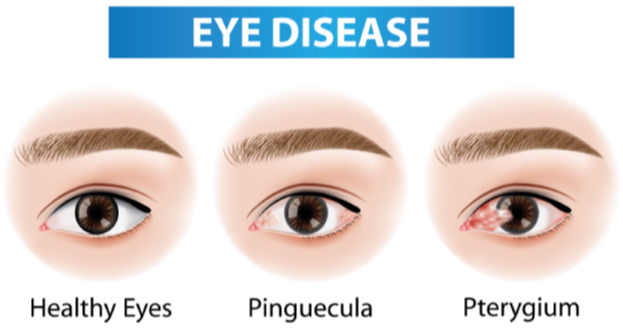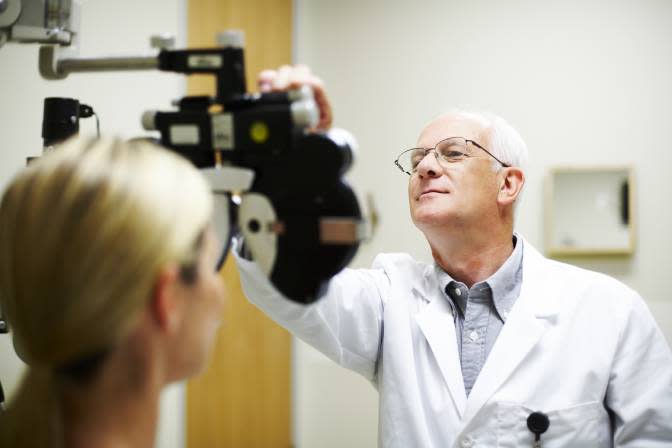Buy One, Get One 50% OFF Eyeglasses
* Restrictions apply. Ask a Team Member for details.
Pterygium Treatment: Eye Care For “Surfer’s Eye” in Arizona

Visit The Eye Care Specialists of Nationwide Vision
Pterygium is a noncancerous eye condition that affects over three million people in the United States each year.
Pterygium is often referred to as Surfer’s Eye because it is largely linked to ultraviolet light exposure. This eye condition is most often diagnosed in people who spend a lot of time outdoors. It occurs when a growth of tissue forms on the outer layer of your eye. While it is not a serious condition, a pterygium can cause discomfort and impact your vision.
With the most advanced technology available, our doctors can determine the severity of the pterygium and provide the best treatment plan for you.

Find Pterygium Treatment at a Nationwide Vision Near You
At Nationwide Vision, we aim to provide every patient with their best vision possible. We offer several locations throughout the state of Arizona including cities like Phoenix, Scottsdale, San Tan Valley, and Tuscan. Click to find which of our locations is closest to you!
What Is a Pterygium?
A pterygium is a growth of tissue that can affect one eye or both and can affect people of all ages. It begins on the conjunctiva, the clear outer layer that covers the white part of your eye, and can grow onto the cornea.
This benign growth forms a triangular shape that is slightly raised and contains blood vessels, often causing irritation and redness. It may appear yellow at first and become flesh-colored over time.
While it may not impact your sight in early stages, if left untreated, a pterygium can spread over the front surface of your eye and cause blurred or double vision.
Pterygium Risk Factors
A pterygium is a common eye condition that affects millions of people of all ages. Sun exposure is the main cause of a pterygium. For this reason, people who spend a lot of time outdoors or live in warmer climates are most at risk. Other risk factors include dry eyes and exposure to pollen, sand, smoke, and wind.
To avoid pterygium, wear sunglasses when spending time outdoors to protect your eyes from the UV light and environmental irritants. Be sure to use over-the-counter eye drops (artificial tears) when your eyes are dry, red, or irritated. Scheduling routine eye exams is always recommended to ensure you’re experiencing your best vision possible.
Common Pterygium Treatments
Pterygium doesn’t always require treatment but may need treatment if it is blocking your vision or causing severe discomfort. Eye drops or ointments with corticosteroids may be used to reduce inflammation.
In some cases, your doctor may recommend surgery if the growth causes extreme discomfort or causes vision loss.
During this painless, outpatient procedure, your doctor will remove the pterygium and replace it with a conjunctival or amniotic membrane graft. Surgery may also be performed for cosmetic reasons.

Schedule an Eye Exam with Nationwide Vision in Arizona
Pterygium is a common eye condition that can affect all members of your family. At Nationwide Vision, we provide expert, compassionate eye care, and treat eye conditions for patients of all ages. If you believe you or your loved one may have a pterygium, schedule an exam at one of our eye care centers today.
If you’re experiencing extreme discomfort, vision loss, or have a past record of eye diseases, visit a Nationwide Vision near you. Click to schedule an eye exam.
Frequently Asked Questions About Pterygium
While a pterygium may stop growing or clear up on its own, treatment is often necessary. If you see or feel a growth on your eye, or experience redness, itchiness, or loss in vision, call us to schedule an appointment with Nationwide Vision today.
Your eye doctor may recommend surgery to remove the pterygium if eye drops or ointments do not provide relief or the growth impacts your vision. We will work with you to determine the best treatment option to help you experience life pain-free and with the best vision possible.
To avoid a pterygium, wear sunglasses with ultraviolet protection when spending time outdoors to protect your eyes from sun damage and airborne pollutants. Use over-the-counter eye drops when your eyes are dry, red, or irritated.